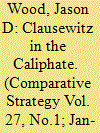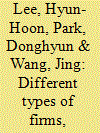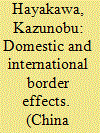| Srl | Item |
| 1 |
ID:
081290


|
|
|
|
|
| Publication |
2008.
|
| Summary/Abstract |
Out of necessity, military doctrine evolves in response to changes in the strategic and tactical environment. In the time since Clausewitz first articulated the center of gravity (COG) concept, his theory has taken many forms that reflect the ever-changing nature of warfare. In the post-9/11 security environment, COG doctrine must be further revised in order to be of use against the elusive, asymmetric enemies that now threaten the United States and its allies. These revisions must focus on redefining the concept and its applicability, as well as on how to identify enemy COGs.
|
|
|
|
|
|
|
|
|
|
|
|
|
|
|
|
| 2 |
ID:
120623


|
|
|
|
|
| Publication |
2013.
|
| Summary/Abstract |
Using highly disaggregated HS 8-digit product-category level data collected by the Chinese Customs Office for 2000 and 2008, we perform an in-depth anatomy of China's imports of manufactured goods. We estimate both the extensive margins - number of products imported per product group or trade partner - and intensive margins - amount of imports per product group or trade partner - of China's imports. Our paper contributes to the literature of firm heterogeneity in international trade in three different ways. First, we distinguish firms into foreign firms and domestic firms, which are further divided into private firms and public firms. Second, we distinguish products into final goods and intermediate goods. Third, we estimate gravity equations from the perspective of dynamics utilizing a dynamic adjustment model. Overall, our analysis yields a number of new stylized facts about China's imports. These, in turn, help us to gain a fuller understanding of China's trade patterns in light of its recent emergence as a globally significant importer.
|
|
|
|
|
|
|
|
|
|
|
|
|
|
|
|
| 3 |
ID:
159036


|
|
|
|
|
| Summary/Abstract |
Previous studies in the border-effect literature surprisingly found that domestic border effects are larger than international border effects (e.g., in the United States or Brazil). One interpretation of this result is that these estimates include the effects of producer agglomeration. Therefore, in this study, we estimate those border effects exclusively for transactions for final consumption, in which such agglomeration forces will be weak, in China and Japan. As a result, we found larger international border effects and could not find a significant role for producer agglomeration in the estimates of border effects. We also found that China's accession to the World Trade Organization reduces border effects in trading between China and Japan but does not decrease domestic border effects.
|
|
|
|
|
|
|
|
|
|
|
|
|
|
|
|
| 4 |
ID:
161819


|
|
|
|
|
| Summary/Abstract |
Chinese foreign policy is mainly characterized by the Beijing consensus and the one-China principle in international relations. More precisely, the situation faced by Taiwan is a “core interest” in China's economic diplomacy strategy. We investigate whether the “one-China policy” (OCP) has had visible effects on bilateral trade flows. In other words, does the compliance of diplomatic commitments with China undermine Taiwanese trade and enhance China's trade position? Using a structural gravity model based on worldwide panel data for the period 1948–2012, we approximate the OCP through two dummy variables: the vote by countries of the UN resolution about China's recognition in 1971 and the existence of diplomatic ties with China. The first component of the OCP drastically increased on average in trade flows with China regardless of the vote of trading partners concerning this UN resolution as well as that for Taiwan. On average, results suggest that diplomatic relations with China improve bilateral trade flows for China, but a trade-deteriorating effect appears for Taiwan with certain ex-colonies. We also find that the effects of these economic diplomacy components confirm previous results reported for the period studied.
|
|
|
|
|
|
|
|
|
|
|
|
|
|
|
|
| 5 |
ID:
132571


|
|
|
|
|
| Publication |
2014.
|
| Summary/Abstract |
The paper estimates Myanmar's export potential based on bilateral export patterns observed for six countries in Southeast Asia. Against that benchmark and controlling for outliers, Myanmar is found to be trading at about 15 per cent of its potential. The bulk of this gap is explained by low trade with industrialized countries. It is conjectured that economic reforms and integration with the world economy are likely to close this gap to potential rather swiftly, particularly if Myanmar can manage to capitalize on its favourable predisposition to international trade.
|
|
|
|
|
|
|
|
|
|
|
|
|
|
|
|